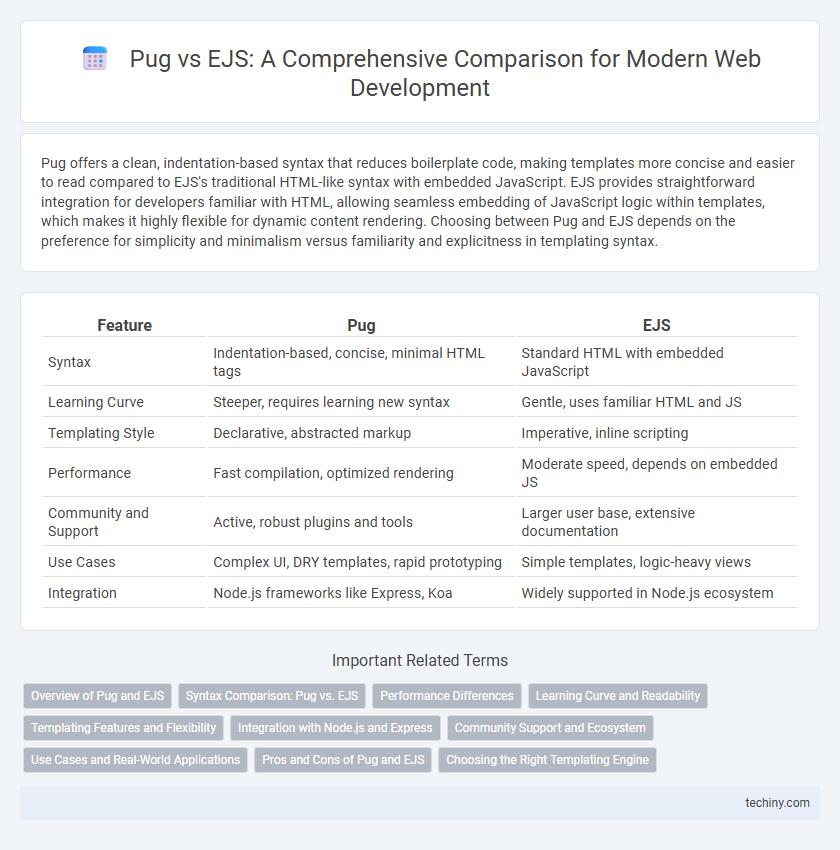Pug offers a clean, indentation-based syntax that reduces boilerplate code, making templates more concise and easier to read compared to EJS's traditional HTML-like syntax with embedded JavaScript. EJS provides straightforward integration for developers familiar with HTML, allowing seamless embedding of JavaScript logic within templates, which makes it highly flexible for dynamic content rendering. Choosing between Pug and EJS depends on the preference for simplicity and minimalism versus familiarity and explicitness in templating syntax.
Table of Comparison
| Feature | Pug | EJS |
|---|---|---|
| Syntax | Indentation-based, concise, minimal HTML tags | Standard HTML with embedded JavaScript |
| Learning Curve | Steeper, requires learning new syntax | Gentle, uses familiar HTML and JS |
| Templating Style | Declarative, abstracted markup | Imperative, inline scripting |
| Performance | Fast compilation, optimized rendering | Moderate speed, depends on embedded JS |
| Community and Support | Active, robust plugins and tools | Larger user base, extensive documentation |
| Use Cases | Complex UI, DRY templates, rapid prototyping | Simple templates, logic-heavy views |
| Integration | Node.js frameworks like Express, Koa | Widely supported in Node.js ecosystem |
Overview of Pug and EJS
Pug is a high-performance template engine for Node.js that uses an indentation-based syntax to simplify HTML markup and improve readability. EJS (Embedded JavaScript) allows developers to embed JavaScript code directly within HTML, offering flexibility and straightforward integration with Express.js. Both Pug and EJS streamline server-side rendering by enabling dynamic content generation in web applications.
Syntax Comparison: Pug vs. EJS
Pug features a concise, indentation-based syntax that eliminates the need for closing tags and braces, making it highly readable and faster to write compared to EJS, which uses standard HTML markup with embedded JavaScript for template logic. EJS offers greater familiarity for developers comfortable with HTML and allows inline JavaScript execution, while Pug's syntax emphasizes minimalism and a cleaner structure by abstracting HTML elements into nested blocks. The choice between Pug and EJS syntax impacts maintainability and learning curve, with Pug favoring developers seeking brevity and streamlined templates, and EJS appealing to those prioritizing explicit HTML templating.
Performance Differences
Pug offers faster template compilation due to its concise syntax and efficient parsing engine, which reduces the rendering time in server-side applications. EJS, while slightly slower, provides a more straightforward and familiar JavaScript-like syntax that can be easier to integrate, but its performance may degrade in complex templates with extensive logic. Benchmark tests reveal Pug can improve response times by up to 20% compared to EJS in high-traffic web environments, making it preferable for performance-critical projects.
Learning Curve and Readability
Pug features a terse syntax with indentation-based structure, requiring developers to learn new conventions but enabling faster template writing once mastered. EJS uses plain HTML with embedded JavaScript, offering a gentler learning curve for those familiar with HTML but resulting in more verbose templates. Readability in Pug can improve code compactness and clarity for experienced users, while EJS templates remain straightforward and easily understandable for beginners.
Templating Features and Flexibility
Pug offers a clean syntax with indentation-based structure, enabling faster template writing and easier maintenance, while EJS uses plain HTML with embedded JavaScript, providing greater familiarity and direct control over code. Pug's templating features include mixins, inheritance, and interpolation, enhancing reusability and modularity, whereas EJS excels in flexibility by allowing arbitrary JavaScript execution within templates for dynamic content rendering. The choice between Pug and EJS depends on the project's need for concise syntax versus explicit JavaScript integration and customization in web development.
Integration with Node.js and Express
Pug and EJS are popular templating engines integrated seamlessly with Node.js and Express for dynamic web page rendering. Pug offers a concise, indentation-based syntax that directly compiles to HTML, enhancing readability and reducing code verbosity in Express applications. EJS uses plain HTML with embedded JavaScript, providing greater flexibility and simplicity for developers familiar with standard HTML, making it straightforward to integrate within Node.js and Express frameworks.
Community Support and Ecosystem
Pug boasts a robust community with extensive resources, plugins, and frequent updates, making it ideal for developers seeking a mature ecosystem. EJS also offers strong community support with a vast array of middleware integrations and compatibility with numerous frameworks, ensuring seamless project scalability. Both templating engines benefit from active GitHub repositories and extensive online documentation, supporting developers through diverse project needs.
Use Cases and Real-World Applications
Pug excels in projects requiring clean, minimalistic syntax and rapid HTML templating, making it ideal for Node.js-based single-page applications and real-time dashboards. EJS is preferred in traditional server-side rendering scenarios where straightforward JavaScript integration and embedding dynamic content into HTML are critical, such as content management systems and e-commerce platforms. Both templating engines integrate seamlessly with Express.js, but Pug's indentation-based structure enhances code readability, while EJS's simplicity favors developers seeking minimal learning curves.
Pros and Cons of Pug and EJS
Pug offers a concise syntax that reduces code clutter by eliminating the need for closing tags, enhancing readability and maintainability in complex templates, though its unique indentation rules can introduce a learning curve. EJS uses plain HTML with embedded JavaScript, making it intuitive for developers familiar with standard web markup and allowing flexible scripting, but it can result in more verbose code and less separation of concerns. Choosing between Pug and EJS depends on project requirements for template clarity versus straightforward integration with existing HTML and JavaScript.
Choosing the Right Templating Engine
Choosing the right templating engine depends on project requirements and developer preferences. Pug offers concise, whitespace-sensitive syntax that enhances readability and reduces code length, making it ideal for complex HTML structures. EJS uses standard HTML with embedded JavaScript, providing familiarity and flexibility for developers working with traditional markup and dynamic content.
Pug vs EJS Infographic

 techiny.com
techiny.com